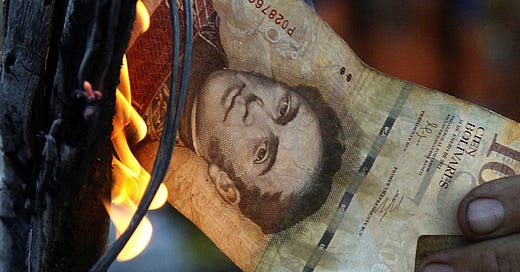The Policies That Led to Venezuela's Downfall: A Timeline
Introduction
Venezuela's rapid descent from one of Latin America's wealthiest nations to a country in crisis is a stark reminder of the consequences of certain political and economic decisions. Below is a timeline of eleven key policies and actions that contributed to Venezuela's downfall.
1. Nationalization of Industries (2007–2012)
Hugo Chávez began an extensive nationalization campaign in 2007, targeting key industries like telecommunications, electricity, and oil. The nationalization of CANTV in 2007 and Electricidad de Caracas the same year marked the start, with the oil sector, particularly the Orinoco Belt oil projects, coming under state control. By 2012, the government had taken over additional sectors like gold mining and steel production. These moves stifled innovation, reduced efficiency, and led to widespread economic mismanagement.
2. Price Controls (2003)
In an effort to curb inflation and make basic goods more affordable, Chávez introduced strict price controls in 2003. These controls covered essential items such as food and medicine, leading to severe shortages as producers couldn't cover costs. The resulting black markets and scarcity of goods crippled the economy and exacerbated public suffering.
3. Currency Controls and Devaluation (2003)
Chávez's government imposed currency exchange controls through CADIVI in 2003, creating a fixed exchange rate system intended to manage foreign currency reserves. Over the years, the bolívar underwent significant devaluations, particularly in 2010 and 2013, leading to hyperinflation. This eroded the purchasing power of Venezuelans and destabilized the economy.
4. Excessive Public Spending (1999–2013)
From the onset of Chávez’s presidency in 1999, there was a dramatic increase in public spending, largely funded by oil revenues. The "Misiones" social programs were launched to reduce poverty and inequality, but this spending became unsustainable. As oil prices dropped in 2014, the government was left with massive fiscal deficits, resulting in the collapse of public services and infrastructure.
5. Erosion of Private Property Rights (2001, 2005 onwards)
The erosion of private property rights began with the 2001 Land Law, which facilitated land reform and expropriation. From 2005 onwards, Chávez's government expanded its seizures to include private businesses, factories, and agricultural estates. These actions discouraged both domestic and foreign investment, further crippling the economy and eroding trust in the government's commitment to property rights.
6. Populist Redistribution Policies (2003–2013)
Chávez launched a series of social welfare programs under the "Misiones" banner in 2003, aiming to redistribute wealth to the poor. These programs were popular but fiscally unsustainable, especially as they were heavily reliant on oil revenues. Over time, they created a dependency on the state and disincentivized productivity, contributing to the economic crisis when oil prices fell.
7. Centralization of Power (1999–2017)
Chávez began consolidating power shortly after taking office in 1999, rewriting the constitution to enhance executive authority. This centralization of power accelerated after his 2006 re-election. His successor, Nicolás Maduro, continued this trend, culminating in the dissolution of the opposition-controlled National Assembly in 2017. This erosion of democratic institutions paved the way for authoritarian rule.
8. Media Control and Censorship (2004 onwards)
The Chávez government began exerting control over the media following the failed 2002 coup attempt. In 2004, the government passed the Law on Social Responsibility in Radio and Television, which allowed for increased regulation of broadcast content. The state took over opposition media outlets, shut down independent news stations, and intimidated journalists. This media control allowed the government to shape public perception, suppress dissent, and eliminate opposition voices, further entrenching authoritarian rule.
9. Mismanagement of Oil Revenues (1999 onwards)
From 1999, when Chávez took office, the state oil company PDVSA became increasingly politicized, with revenues diverted to fund social programs instead of being reinvested in the industry. The failure to diversify the economy or save during times of high oil prices left the country vulnerable. When oil prices fell in 2014, the economy collapsed due to a lack of investment and over-reliance on oil revenues.
10. Militarization and Corruption (2002 onwards)
Following the 2002 coup attempt against Chávez, the military gained increased influence within the government. Chávez began appointing military officers to key government positions, leading to the militarization of the state. Corruption became rampant, as military and political elites consolidated control over the economy, exacerbating mismanagement and undermining public trust in government institutions.
11. Suppression of Political Opposition (2004 onwards)
The systematic suppression of political opposition began after Chávez survived the 2004 recall referendum. Over the years, this repression escalated, with violent crackdowns on protests in 2014 and 2017, and the disqualification of opposition candidates in 2018. This suppression prevented any meaningful political reform, deepening the country's crisis and entrenching authoritarian rule.
Conclusion
The downfall of Venezuela is a complex narrative of political and economic mismanagement. The combination of nationalization, centralization of power, media control, and the suppression of opposition laid the groundwork for the country's current crisis. These policies serve as a powerful cautionary tale of the dangers of ideologically-driven governance and the potential consequences of unchecked state control.




